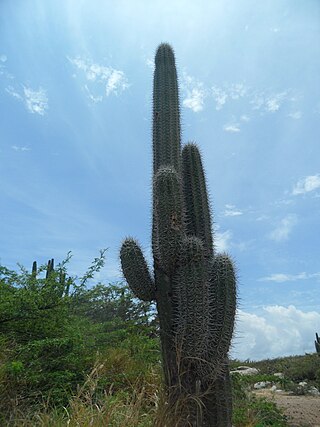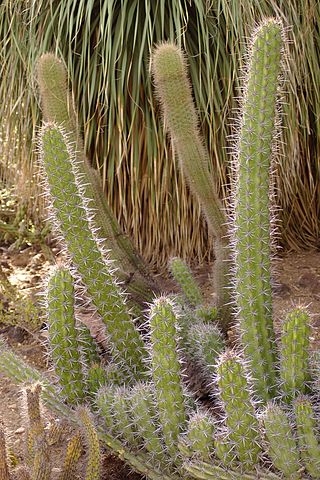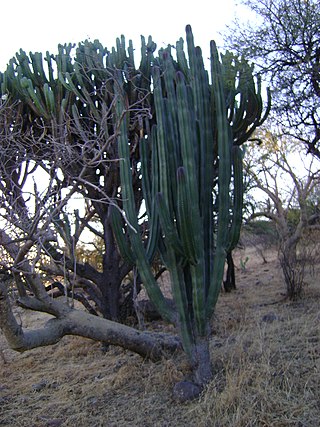
Isolatocereus is a monotypic genus of flowering plant in the family Cactaceae. The only species is Isolatocereus dumortieri that is found in Mexico.

Stenocereus alamosensis is a species of cactus native to Mexico.

Stenocereus griseus, also known as the Mexican organ pipe, dagger cactus, pitaya, and pitayo de mayo, is a species of cactus.

Stenocereus queretaroensis is a species of cactus from Mexico, including the state of Querétaro. It is cultivated for its fruit.

Ferocactus gracilis, the fire barrel cactus, is a species of Ferocactus from Northwestern Mexico. This cactus gets its common name from the striking red coloration of its defensive spines and flowers.

Stenocereus gummosus is a flowering plant in the family Cactaceae that is found in Baja California, Mexico at elevations of 9 to 134 meters

Stenocereus stellatus is a flowering plant in the family Cactaceae that is found in Oaxaca, Mexico

Stenocereus montanus, known as sahuira, is a species of columnar cactus in the family Cactaceae.

Stenocereus heptagonus is a species of cactus.
Stenocereus martinezii is a species of flowering plant in the family Cactaceae, native to Sinaloa in Mexico. A candelabriform cactus typically 5 to 7 m tall, it is easy to propagate from cuttings, so local people use it to build live fences.

Pachycereus weberi is a columnar cactus plant native to Mexico.

Stenocereus treleasei, commonly known as tunillo, is a species of flowering plant in the family Cactaceae, native to Oaxaca in Mexico.

Cochemiea theresae is a species of cactus in the subfamily Cactoideae.

Stenocereus beneckei is a species of cactus in the genus Stenocereus, endemic to Mexico.
Stenocereus fricii is a species of cactus in the genus Stenocereus, endemic to Mexico.
Stenocereus chacalapensis is a species of cactus in the genus Stenocereus, endemic to Mexico.
Stenocereus chrysocarpus is a species of cactus in the genus Stenocereus, endemic to Mexico.
Stenocereus humilis is a species of cactus in the genus Stenocereus, endemic to Mexico.
Stenocereus zopilotensis is a species of cactus in the genus Stenocereus, endemic to Mexico.
Stenocereus standleyi is a species of cactus in the genus Stenocereus, endemic to Mexico.














